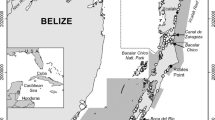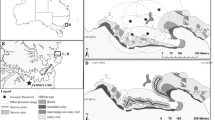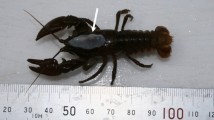Abstract
Crayfish are regarded as useful indicators of environmental quality and freshwater biodiversity. However, reliable methods for monitoring their populations are needed so that this potential can be fully utilised. We report and discuss methodological aspects of the white-clawed crayfish (Austropotamobius pallipes complex) survey conducted in Piedmont, Italy, with the use of mark-recapture. The results suggest that the method can serve as a convenient tool for estimating the size of crayfish populations and inferring their temporal trends. The two populations investigated appeared closed except for wintertime and July. Consequently, the Robust Design, which is regarded as the most reliable mark-recapture approach, can be easily applied. The minimum effective sampling plan for monitoring purposes should comprise one primary period per year, conducted in the summer–autumn season, and consisting of three capture sessions. If gaining insight into the ecology of the investigated species is the prime objective and sufficient resources are available, the optimal plan should include two primary periods (in spring and the summer–autumn season) of five capture sessions each. Capture sessions need to be separated by roughly 2-week intervals in order to avoid the strong, but short-term, negative effect of capturing crayfish on their recapture chances. As the model without heterogeneity in capture probabilities ensures better estimate precision we recommend that data collected for both sexes are analysed separately. Taking into consideration higher male catchabilities and sex ratio being invariably 1:1, it also seems beneficial to estimate only male numbers and double them to achieve total population sizes.




Similar content being viewed by others
References
Abrahamsson S (1983) Trappability, locomotion, and diel pattern of activity of the crayfish Astacus astacus and Pacifastacus leniusculus Dana. Freshw Crayfish 5:239–253
Acosta CA, Perry SA (2000) Effective sampling area: a quantitative method for sampling crayfish population in freshwater marshes. Crustaceana 73:425–431. doi:10.1163/156854000504516
Akaike H (1973) Information theory and an extension of the maximum likelihood principle. In: Petrov BN, Csaki F (eds) Second international symposium on information theory. Akademiai Kiado, Budapest, pp 267–281
Arnason AN, Mills KH (1981) Bias and loss of precision due to tag loss in Jolly-Seber estimates for mark-recapture experiments. Can J Fish Aquat Sci 38:1077–1095
Arnason AN, Schwarz CJ (1999) Using POPAN-5 to analyse banding data. Bird Study 46(Suppl):157–168
Baillie SR (1995) Uses of ringing data for the conservation and management of bird populations: a ringing scheme perspective. J Appl Stat 22:967–987. doi:10.1080/02664769524748
Baillie J, Groombridge B (eds) (1996) 1996 IUCN red list of threatened animals. IUCN, Gland
Bubb DH, Lucas MC, Timothy J, Thom TJ (2002) Winter movements and activity of signal crayfish Pacifastacus leniusculus in an upland river, determined by radio telemetry. Hydrobiologia 483:111–119. doi:10.1023/A:1021363109155
Bubb DH, Thom TJ, Lucas MC (2006) Movement patterns of the invasive signal crayfish determined by PIT telemetry. Can J Zool 84:1202–1209. doi:10.1139/Z06-100
Byron CJ, Wilson A (2001) Rusty crayfish (Orconectes rusticus) movement within and between habitats in Trout Lake, Vilas County, Wisconsin. J North Am Benthol Soc 20:606–614. doi:10.2307/1468091
Chao A (1989) Estimating population size for sparse data in capture-recapture experiments. Biometrics 45:427–438. doi:10.2307/2531487
Chao A, Lee SM, Jeng SL (1992) Estimation of population size for capture-recapture data when capture probabilities vary by time and individual animal. Biometrics 48:201–216. doi:10.2307/2532750
Crawford L, Yeomans WE, Adams CE (2006) The impact of introduced signal crayfish Pacifastacus leniusculus on stream invertebrate communities. Aquat Conserv 16:611–621. doi:10.1002/aqc.761
DiStefano RJ, Gale CM, Wagner BA, Zweifel RD (2003) A sampling method to assess lotic crayfish communities. J Crust Biol 23:678–690. doi:10.1651/C-2364
Dorn NJ, Mittelbach GG (1999) More than predator and prey: a review of interactions between fish and crayfish. Vie Milieu 49:229–237
Dorn NJ, Urgelles R, Trexler JC (2005) Evaluating active and passive sampling methods to quantify crayfish density in a freshwater wetland. J North Am Benthol Soc 24:346–356. doi:10.1899/04-037.1
Flowerdew JR, Shore RF, Poulton SMC, Sparks TH (2004) Live trapping to monitor small mammals in Britain. Mammal Rev 34:31–50. doi:10.1046/j.0305-1838.2003.00025.x
Fratini S, Zaccara S, Barbaresi S, Grandjean F, Souty-Grosset C, Crosa G et al (2005) Phylogeography of the threatened crayfish (genus Austropotamobius) in Italy: implications for its taxonomy and conservation. Heredity 94:108–118. doi:10.1038/sj.hdy.6800891
Frisch AJ, Hobbs JPA (2006) Long term retention of internal elastomer tags in a wild population of painted crayfish (Panulirus versicolor [Latreille]) on the Great Barrier Reef. J Exp Mar Biol Ecol 339:104–110. doi:10.1016/j.jembe.2006.07.016
Gherardi F (2006) Crayfish invading Europe: the case study of Procambarus clarkii. Mar Freshw Behav Physiol 39:175–191. doi:10.1080/10236240600869702
Gherardi F, Holdich D (eds) (1999) Crayfish in Europe as alien species: how to make the best of a bad situation? Crustacean Issues, vol 11. Balkema, Rotterdam
Gherardi F, Souty-Grosset C (eds) (2006) European crayfish as heritage species-linking research and management strategies to conservation and socio-economic development, CRAYNET, vol 4. Bull Fr Pêche Piscic 380–381:1–566
Gherardi F, Barbaresi S, Salvi G (2000) Spatial and temporal patterns in the movement of Procambarus clarkii, an invasive crayfish. Aquat Sci 62:179–193
Gledhill T, Sutcliffe DW, Williams WD (1993) British freshwater Crustacea Malacostraca, 2nd edn. Freshwater Biological Association Scientific Publications 52. Freshwater Biological Association, Ambleside
Grandjean F, Frelon-Raimond M, Souty-Grosset C (2002) Compilation of molecular data for the phylogeny of the genus Austropotamobius: one species or several? Bull Fr Peche Piscic 367:671–680
Guan RZ (1997) An improved method for marking crayfish. Crustaceana 70:641–652. doi:10.1163/156854097X00104
Guan RZ, Wiles PR (1996) Growth, density and biomass of crayfish, Pacifastacus leniusculus, in a British lowland river. Aquat Living Resour 9:265–272. doi:10.1051/alr:1996030
Hicks BJ (2003) Distribution and abundance of fish and crayfish in a Waikato stream in relation to basin area. NZ J Zool 30:149–160
Hockley NJ, Jones JPG, Andriahajaina FB, Manica A, Ranambitsoa EH, Randriamboahary JA (2005) When should communities and conservationists monitor exploited resources? Biodivers Conserv 14:2795–2806. doi:10.1007/s10531-005-8416-8
Holdich DM (2003) Ecology of the white-clawed crayfish Austropotamobius pallipes. Conserving natura 2000 rivers, ecology series no. 1. English Nature, Peterborough
Holdich DM, Lowery RS (eds) (1988) Freshwater crayfish—biology, management and exploitation. Croom Helm, London
Holdich DM, Reeve ID (1991) The distribution of freshwater crayfish in the British Isles with particular reference to crayfish plague, alien introductions and water quality. Aquat Conserv 1:139–158. doi:10.1002/aqc.3270010204
Hurvich CM, Tsai C (1989) Regression and time series model selection in small samples. Biometrika 76:297–307. doi:10.1093/biomet/76.2.297
Jay D, Holdich DM (1981) The distribution of the crayfish, Austropotamobius pallipes, in British waters. Freshw Biol 11:121–129. doi:10.1111/j.1365-2427.1981.tb01248.x
Jones JPG, Andriahajaina FB, Hockley NJ, Balmford A, Ravoahangimalala OR (2005) A multidisciplinary approach to assessing the sustainability of freshwater crayfish harvesting in Madagascar. Conserv Biol 19:1863–1871. doi:10.1111/j.1523-1739.2005.00267.x
Jones JPG, Coulson T (2006) Population regulation and demography in a harvested freshwater crayfish from Madagascar. Oikos 112:602–611. doi:10.1111/j.0030-1299.2006.14301.x
Julliard R, Jiguet F, Couvet D (2004) Evidence for the impact of global warming on the long-term population dynamics of common birds. Proc Biol Sci 271:490–492. doi:10.1098/rsbl.2004.0229
Kendall WL (1999) Robustness of closed capture-recapture methods to violations of the closure assumption. Ecology 80:2517–2525
Lancia RA, Nichols JD, Pollock KH (1994) Estimating the number of animals in wildlife populations. In: Bookhout TA (ed) Research and management techniques for wildlife and habitats, 5th edn. The Wildlife Society, Bethesda, pp 215–253
Lodge DM, Kershner MW, Aloi JE, Covich AP (1994) Effects of an omnivorous crayfish (Orconectes rusticus) on a freshwater littoral food web. Ecology 75:1265–1281. doi:10.2307/1937452
Lodge DM, Taylor CA, Holdich DM, Skurdal J (2000) Nonindigenous crayfishes threaten North American freshwater biodiversity: lessons from Europe. Fisheries 25:7–20 doi:10.1577/1548-8446(2000)025<0007:NCTNAF>2.0.CO;2
Lowery RS (1988) Growth, moulting and reproduction. In: Holdich DM, Lowery RS (eds) Freshwater crayfish: biology, management and exploitation. Croom Helm, London, pp 83–113
Maguire I, Erben R, Klobucar GIV, Lajtner J (2002) Year cycle of Austropotamobius torrentium (Schrank) in streams on Medvednica Mountain (Croatia). Bull Fr Peche Piscic 367:943–957
Maguire I, Hudina S, Erben R (2004) Estimation of noble crayfish (Astacus astacus L.) population size in the Velika Paklenica Stream (Croatia). Bull Fr Peche Piscic 372:353–366. doi:10.1051/kmae:2004009
Marunouchi J, Kusano T, Ueda H (2002) Fluctuation in abundance and age structure of a breeding population of the Japanese brown frog, Rana japonica Gunther (Amphibia, Anura). Zool Sci 19:343–350. doi:10.2108/zsj.19.343
Menkens GE Jr, Anderson SH (1988) Estimation of small-mammal population size. Ecology 69:1952–1959. doi:10.2307/1941172
Moore JA, Hoare JM, Daugherty CH, Nelson NJ (2007) Waiting reveals waning weight: monitoring over 54 years shows a decline in body condition of a long-lived reptile (tuatara, Sphenodon punctatus). Biol Conserv 135:181–188. doi:10.1016/j.biocon.2006.10.029
Nowicki P, Witek M, Skórka P, Settele J, Woyciechowski M (2005) Population ecology of endangered butterflies Maculinea teleius and M. nausithous and its conservation implications. Popul Ecol 47:193–202. doi:10.1007/s10144-005-0222-3
Nowicki P, Settele J, Henry P-Y, Woyciechowski M (2008) Butterfly monitoring methods: the ideal and the real world. Isr J Ecol Evol 54:69–88
Nyström P, Brönmark C, Graneli W (1996) Patterns in benthic food webs: a role for omnivorous crayfish? Freshw Biol 36:631–646. doi:10.1046/j.1365-2427.1996.d01-528.x
Otis DL, Burnham KP, White DC, Anderson DR (1978) Statistical inference from capture data on closed animal populations. Wildl Monogr 62:1–135
Parkyn SM, Collier KJ, Hicks BJ (2002) Growth and population dynamics of crayfish Paranephrops planifrons in streams within native forest and pastoral land uses. NZ J Mar Freshw 36:847–861
Peay S (2003) Monitoring the White-clawed crayfish Austropotamobius p. pallipes. Conserving natura 2000 rivers, monitoring series no. 1. English Nature, Peterborough
Pintor LM, Soluk DA (2006) Evaluating the non-consumptive, positive effects of a predator in the persistence of an endangered species. Biol Conserv 130:584–591. doi:10.1016/j.biocon.2006.01.021
Pollock KH (1982) A capture-recapture design robust to unequal probabilities of capture. J Wildl Manage 46:757–760. doi:10.2307/3808569
Pollock KH, Nichols JD, Brownie C, Hines JE (1990) Statistical inference for capture recapture experiments. Wildl Monogr 107:1–97
Pollock KH, Yoshizaki J, Fabrizio MC, Schram ST (2007) Factors affecting survival rates of a recovering lake trout population estimated by mark-recapture in Lake Superior, 1969–1996. Trans Am Fish Soc 136:185–194. doi:10.1577/T05-317.1
Rabeni CF, Collier KJ, Parkyn SM, Hicks BJ (1997) Evaluating methods of sampling stream crayfish. NZ J Mar Freshw 31:693–700
Rexstad EA, Burnham KP (1991) User’s guide for interactive program CAPTURE. Abundance estimation of closed animal populations. Colorado State University, Fort Collins
Reynolds JD (1998) Conservation management of the white-clawed crayfish, Austropotamobius pallipes. Part 1. Irish Wildlife Manuals 1, Dublin
Reynolds J, Souty-Grosset C (eds) (2003) The endangered native crayfish Austropotamobius pallipes, bioindicator and heritage species, CRAYNET, vol 1. Bull Fr Pêche Piscic 370–371:1–230
Reynolds JD, Gouin N, Pain S, Grandjean F, Demers A, Souty-Grosset C (2001) Irish crayfish populations: ecological survey and preliminary genetic findings. Freshw Crayfish 13:584–594
Robinson CA, Thom TJ, Lucas MC (2000) Ranging behaviour of a large freshwater invertebrate, the white-clawed crayfish Austropotamobius pallipes. Freshw Biol 44:509–521. doi:10.1046/j.1365-2427.2000.00603.x
Rodríguez CF, Bécares E, Fernández-Aláez M, Fernández-Aláez C (2005) Loss of diversity and degradation of wetlands as a result of introducing exotic crayfish. Biol Invasions 7:75–85. doi:10.1007/s10530-004-9636-7
Rogowski DL, Stockwell CA (2006) Assessment of potential impacts of exotic species on populations of a threatened species, White Sands pupfish, Cyprinodon tularosa. Biol Invasions 8:79–87. doi:10.1007/s10530-005-0238-9
Rosenthal SK, Stevens SS, Lodge DM (2006) Whole-lake effects of invasive crayfish (Orconectes spp.) and the potential for restoration. Can J Fish Aquat Sci 63:1276–1285. doi:10.1139/F06-037
Santucci F, Iaconelli M, Andreani P, Cianchi R, Nascetti G, Bullini L (1997) Allozyme diversity of European freshwater crayfish of the genus Austropotamobius. Bull Fr Pêche Piscic 347:663–676
Scalici M, Gibertini G (2005) Can Austropotamobius italicus meridionalis be used as a monitoring instrument in Central Italy? Preliminary observations. Bull Fr Peche Piscic 376–377:613–625
Schwarz CJ, Arnason AN (1996) A general methodology for the analysis of capture-recapture experiments in open populations. Biometrics 52:860–873. doi:10.2307/2533048
Schwarz CJ, Seber GAF (1999) Estimating animal abundance. Stat Sci 14:427–456. Review III. doi:10.1214/ss/1009212521
Skalski JR, Robson DS (1992) Techniques for wildlife investigations. Academic Press, San Diego
Skurdal J, Qvenild T, Taugbøl T, Fjeld E (1990) A 6-year study of Thelohania contejeani parasitism of the noble crayfish, Astacus astacus L, in lake Steinsfjorden, SE Norway. J Fish Dis 13:411–415. doi:10.1111/j.1365-2761.1990.tb00800.x
Souty-Grosset C, Holdich DM, Noel PY, Reynolds JD, Haffner P (eds) (2006) Atlas of crayfish in Europe. Muséum National d’Histoire Naturelle, Paris
Taugbøl T, Skurdal J (1999) The future of native crayfish in Europe—how to make the best of a bad situation? Crustac Issues 11:271–279
Tirelli T, Mussat Sartor R, Bona F, De Biaggi E, Zocco D, Badino G et al Census of Austropotamobius genus in four Districts of Piedmont (Western Italy). Bol Mus Reg Sci Nat Torino (in press)
Usio N, Townsend CR (2004) Roles of crayfish: consequences of predation and bioturbation for stream invertebrates. Ecology 85:807–822. doi:10.1890/02-0618
van Helddingen PJ, Willemse I, Speight MCD (eds) (1996) Background information on the invertebrates of the habitats directive and the bern convention. Part 1-Crustacea, Coleoptera and Lepidoptera. Nature and environment no. 79. Council of Europe Publishing, Strasbourg
Webb M, Richardson A (2004) A radio telemetry study of movement in the giant Tasmanian freshwater crayfish, Astacopsis gouldi. Freshw Crayfish 14:197–204
Westman K, Savolainen R (2002) Growth of the signal crayfish, Pacifastacus leniusculus, in a small lake in Finland. Boreal Environ Res 7:53–61
Westman K, Savolainen R, Julkunen M (2002) Replacement of the native crayfish Astacus astacus by the introduced species Pacifastacus leniusculus in a small, enclosed Finnish lake: a 30-year study. Ecography 25:53–73. doi:10.1034/j.1600-0587.2002.250107.x
White GC, Burnham KP (1999) Program MARK: survival estimation from populations of marked animals. Bird Study 46:120–138
Whitledge GW, Rabeni CF (1997) Energy sources and ecological role of crayfishes in an Ozark stream: insights from stable isotopes and gut analysis. Can J Fish Aquat Sci 54:2555–2563. doi:10.1139/cjfas-54-11-2555
Williams BK, Nichols JD, Conroy MJ (2002) Analysis and management of animal populations. Academic Press, San Diego
Willis TV, Magnuson JJ (2006) Response of fish communities in five north temperate lakes to exotic species and climate. Limnol Oceanogr 51:2808–2820
Wilson KA, Magnuson JJ, Lodge DM, Hill AM, Kratz TK, Perry WL et al (2004) A long-term rusty crayfish (Orconectes rusticus) invasion: dispersal patterns and community change in a north temperate lake. Can J Fish Aquat Sci 61:2255–2266. doi:10.1139/f04-170
Zhang YX, Richardson JS, Negishi JN (2004) Detritus processing, ecosystem engineering and benthic diversity: a test of predator-omnivore interference. J Anim Ecol 73:756–766. doi:10.1111/j.0021-8790.2004.00849.x
Acknowledgements
This survey was funded by the Piedmont regional government through the project “Action plan for the crayfish Austropotamobius pallipes complex (Crustacea Decapoda Astacidae) in Piedmont”, while the data analysis was supported by the European Commission within its STREP project EuMon (contract no. 006463). We would like to thank Giulia Bemporad, Luca Buonerba, Livio Favaro, Andrea Forchino, and Valentina Jackson for their help in the fieldwork, and James Brookes for improving the English of the manuscript.
Author information
Authors and Affiliations
Corresponding author
Rights and permissions
About this article
Cite this article
Nowicki, P., Tirelli, T., Mussat Sartor, R. et al. Monitoring crayfish using a mark-recapture method: potentials, recommendations, and limitations. Biodivers Conserv 17, 3513–3530 (2008). https://doi.org/10.1007/s10531-008-9425-1
Received:
Accepted:
Published:
Issue Date:
DOI: https://doi.org/10.1007/s10531-008-9425-1




